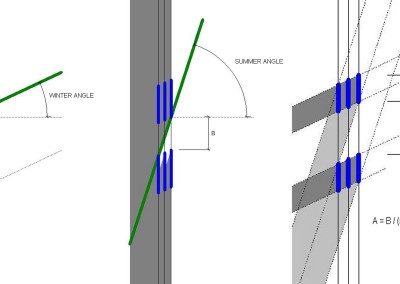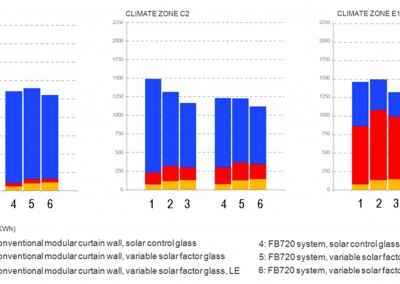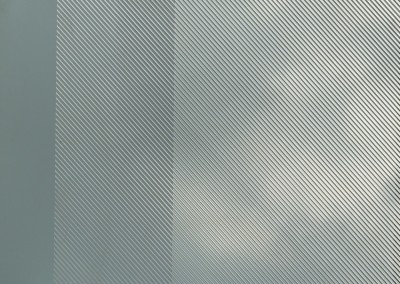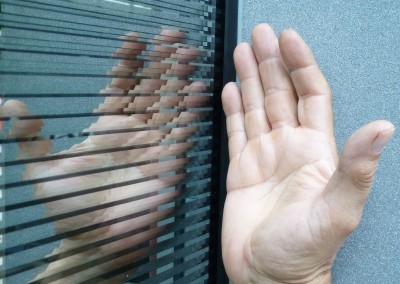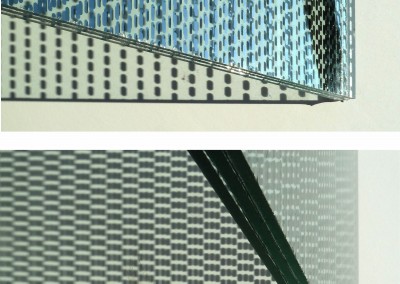BEYOND | call for projects
ENTRY #5 | FB720 project
Project Brief
The aim of the project was to design and develop a lightweight façade with low environmental impact and high energy efficiency, mainly for use in temperate climates. One of the technical strategies to achieve this is the integration of solar control glazing with passive seasonal discrimination. The ultimate purpose is to obtain clearly differentiated solar protection values, according to the angle of incidence of solar radiation. This facilitates the desired heat gains in winter and reduces unwanted contributions in summer.
Currently, glass products are available with a variable solar factor obtained through the interposition of solar filters (microlouvers, metal mesh, etc.) or with reflective microprisms surface treatments. However, these products have several disadvantages: they do not take into account the varying conditions of solar incidence due to latitude, they cannot adapt to the different orientations of each façade, and it is difficult to incorporate areas without treatment in the same unit of glass.
Unlike other variable solar control glazing, FB720 project glass is based on the superimposition of various layers of glass. Solar control is achieved by means of a surface treatment with a geometric pattern that is tailored to the specific characteristics of each project, the building orientation and the latitude. The result is laminated glass containing what could be described as “virtual slats”, which are designed to provide the highest protection from the incidence of direct solar radiation in summer and the greatest collection of solar energy in winter. FB720 project glass can be combined with other sheets of glass to form insulated glazing units with an air cavity, low emissivity coating and reinforced sound insulation, among other features, that can be incorporated into all kinds of wall and façade systems.
The procedure for designing the ideal geometric pattern of “virtual slats” is based on aligning and superimposing different bands in relation to the maximum angles of incidence of radiation at the winter and summer solstices, corrected by the refraction of the glass. The width of the bands, the distance between them and the offset in alignment are determined by the number and thickness of glass layers in the glazing unit. As more superimposed layers are used, the bands can be separated by a greater distance. In the practical cases that were studied, we considered a minimum of three layers created by a reflective, semi-transparent coating of metal oxides on the surface of the glass.
The technique developed for the selective metallization of glass makes possible the application of complex multilayer structures, either as bands or as separate spots with varying degrees of transparency, reflection and metallic color (copper, gold, bronze, etc.). For this case, it has been developed a very reflective coating with transmission values of less than 5%. The main aim of the treatment is to align shade from the bands in winter and superimpose it in summer. This provides passive solar protection that is both variable and seasonal. In other words, the solar factor is lower in the warm months and higher in the cold ones.
the basis of these criteria, various samples and mockups were created. One of the main limitations to consider is tolerance in the relative position of the various bands: for correct functioning, precision must be less than 0.1 mm. The visual transmission characteristics are highly dependent on the transparency and reflectivity of the material in the bands. Although the glass provides good visibility, it is not totally transparent. Visibility depends on the contrast between the exterior and interior lighting. However, the variability produces some interesting aesthetic features, as the attractive appearance changes throughout the day.
Some calculations were made in order to simulate the glass performance. The results confirmed the seasonal behaviour of the glass. The solar factor values for the angle of incidence of direct radiation in summer were lower than 50% of the winter values. The results obtained using the calculation tool were compared with tests carried out in the laboratories of the University of Zaragoza’s Department of Applied Physics. The results coincided with the estimations of theoretical behaviour with an acceptable level of accuracy. Therefore, the simulation tool was validated.
On the basis of these values, several additional simulations were carried out to evaluate the energy performance of the glass. The theoretical demand for heating, cooling and lighting in a typical habitable module was compared for different façade systems. The results show that the use of FB720 project glass in a temperate climate such as that found in the Iberian Peninsula may lead, in some cases, to a 30% lower energy demand than in buildings in which standard solar control glazing is installed.
Therefore, the installation of FB720 project glass has numerous advantages over standard solar control glass and protection systems. FB720 project glass can be used to adapt and tailor the solar protection to each site, building, façade plan and even each glazing unit. Various degrees of transparency and visibility can be incorporated in the same pane of glass. Solar protection can be achieved using a wide range of coatings on glass, with varying levels of reflection, transparency and colour. The treatment can even be combined with decorative coatings. Passive solar protection leads to more reliable building envelope results, and does not depend on the actions of the user. As the coating is incorporated in the glazing, there are no durability or maintenance problems, which occur with other solutions such as blinds or slats. In addition, the treatment reduces the costs of materials used in the façade.
The viability of FB720 project glass for practical applications has been verified by building a complete façade prototype. Satisfactory results were found in the various tests of the prototype carried out to prove its technical suitability: water-tightness, permeability to air, acoustic insulation, stability and strength
The Façade FB720 project is the result of research funded by the Spanish Government’s Centre for Industrial Technological Development (CDTI) (IDI-20090761).

